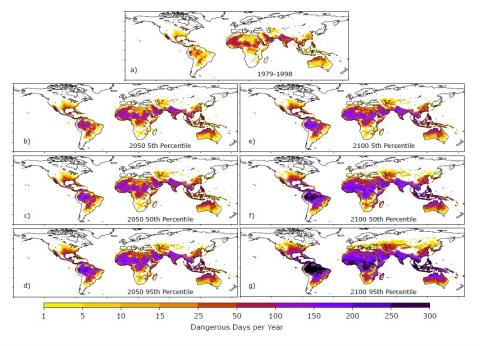Population ageing is expected to lead to significant rises in climate risk because vulnerability rises sharply throughout people’s later years. But what if we account for rising longevity? Does this change our understanding how ageing influences risk? To answer this, it is useful to consider the concept of prospective age, i.e., the years we hypothetically have left to live, rather than the years we have already lived.
Chronological age and prospective age are different lenses through which to view the world and understand the implications of ageing.
What is prospective age for and how is it calculated?
A group of researchers, including myself, have just published two papers that use prospective age to reassess the influence of population ageing on climate risk. One, in npj Climate and Atmospheric Science, focusses on expected increases in the size of older populations across the globe out to 2100; the other, in Environmental Research, looks at ageing and changes in temperature-related mortality in Spain over the last 40 years.
In the articles we explain that when assessing the implications of ageing, it seems natural to classify people by their “chronological age”; that is, the number of years they have lived. Indeed, this is (to our knowledge) the conceptualization adopted in all previous studies of the health risks posed by climate change. In this approach, “population ageing” is essentially understood as increasing proportions of people aged above, say, 65 or 85 years.
However, an alternative conceptualization of ageing, pioneered in demography by Warren Sanderson and Sergei Scherbov, suggests that utilizing only chronological age can be misleading as it fails to account for the dynamics of evolving longevity and changing patterns of health. Instead, they recommend adopting an alternative perspective that views age and ageing in terms of functional ability. The latter may be measured as “prospective age”: the average number of years people of a given chronological age can still expect to live (i.e. conditional or remaining life expectancy).
As people age, their health, disabilities and cognition tend to be more correlated with their prospective than chronological age. These same factors tend to be associated with the risks posed by climate change, including forheat-related mortality.

What does prospective age tell us about future ageing and climate risk across the globe?
In the first analysis, we assessed the expected growth in older populations across the globe in countries grouped by income level. The higher the growth, the greater the share of the highly vulnerable older population, the higher the climate risks.
Using the United Nations´ population projections, we showed that, compared to a chronological age perspective, the expected increase in the size older population was considerably lower when viewed from a prospective age perspective. For instance, in low income countries, the growth in the “old old” (that is, people chronologically aged 85 years+, or, with a prospective age of ≤5 years remaining life expectancy) by 2100 was 32-fold from a chronological perspective but only 10-fold from a chronological perspective. Overall, the differences between the two perspectives increased with age and decreased with country income level. This suggests that, while ageing certainly poses challenges, they may not be as large as we might have thought, particularly for the very old and in countries with the least resources.
We also did an assessment using social scenarios developed for climate impact assessments that assume we give more or less priority to sustainable development (the Shared Socioeconomic Pathways). Here an assessment based on chronological age suggests there are large tradeoffs between the size of the vulnerable older population and the climate challenges they face. That is, a sustainable future may face less climate change, but the high risk older population might be very large.
A sustainable future may face less climate change, but the high risk older population might be very large
In contrast, the prospective age assessment shows the trade-offs are actually considerably smaller. So, in more sustainable futures, while specific policies are certainly needed to prepare for rapid rises in the “old” population, the size of this population – both absolutely and relative to less sustainable futures - is likely to much smaller than thought.
What does prospective age tell us about heat-mortality risk in Spain over the past 40 years?
In our second study, we used prospective age to assess historical changes in the risk of heat-related mortality in a context of climate change and population ageing. If it is getting hotter and the population is getting older and we know that older people are more vulnerable to temperature, what are the consequences for risk? Previous studies based on chronological age suggest susceptability to heat has been falling amongst older people in recent decades, with some seeing this as evidence of successful adaptation. But, what if we account for rising longevity? Has risk fallen as much as we think it has? That is what we wanted to find out; to do so, we analysed mortality and temperature data in Spain between 1980 and 2018.
How much has the temperature in Spain increased?
In the last four decades the temperature has increased in Spain at a rate of 0.33 ºC per decade. In the period 1980-1994 the median daily temperature was 14.3 ºC, while between 2004 and 2018 it was 15.5 ºC, i.e. 1.2 ºC higher.
How much has life expectancy increased in Spain?
Life expectancy at birth, in the case of men, has increased from 72.4 years in 1980 to 80.5 years in 2018. For women, it has increased by 7.4 years in the same period, from 78.4 to 85.8 years.
How has prospective age changed in Spain?
If life expectancy is increasing, so is prospective age at any given chronological age. People of a given chronological age have more years ahead of them in 2024 than in 1980. Therefore, in a sense, one could say that at the same chronological age they are “younger” or, at least, have more life ahead of them than their predecessors. For example, in the study period the regional increase in prospective age of men aged 65 ranged from 3.5 to 5.2 years and for women aged 85 ranged from 1.8 to 2.9 years.
People of a given chronological age have more years ahead of them in 2024 than in 1980
If the temperature rises and the population ages, are we facing higher risk from heat?
To account for the influence of rising longevity, our analysis uses prospective age rather than chronological age. This allows changes in risk to be tracked in groups that are more comparable, in that they have similar levels of functioning and remaining years of life. By taking this approach, we remove the contributions general social progress has made to risk reduction. Doing so gives a better indication of changes in risk that may be due to adaptation – which are actions taken specifically (but consciously or unconsciously) in response to climate change That is, we gain a clearer picture of how successfully we have adapted to climate change so far.
While we agree that there has been a decline in mortality risk at temperature extremes, our results show that this has not been as pronounced as previously thought. Not only that, but we also observe a significant increase in risk at moderately hot temperatures, which may be partly because people are increasingly aware of the dangers of extreme temperatures and take precautions on those days, whereas moderate heat days aren´t usually perceived as being particularly hot or risky.
How much has the risk of dying from heat increased or decreased?
The study provides data that go in opposite directions:
Grouping older people by chronological age shows the absolute risk of mortality from extreme heat was reduced by 54% in women and 48% in men. But using prospective age shows that the risk decreased by only 15% for women and 25% for men.
Older people have not adapted to climate change as much as previously thought
For moderate heat, the analysis based on chronological age shows absolute mortality risk declined by 23% in women and 16% in men. On the other hand, using prospective age the results are quite the opposite, showing an increase in absolute risk of 46% in women and 20% in men.
The upshot is that older people have not adapted to climate change as much as previously thought.
We are getting old later
The general perception, which coincides with the chronological age perspective, is that population ageing will lead to more and more people getting older and older, which, in the case of heat, would lead to large increases in population risk. But in reality, what the prospective age perspective shows us is the postponement of aging; that is, people are getting old later. So, there will be more older people – particularly chronological but also prospectively - in the longer run, but we will not suddenly have an extremely old and frail population.
Warmer and older, but there is reason for optimism
So, we live longer than our fathers and mothers and we are “younger” at the same chronological age. In the context population ageing, the risk posed by higher temperatures can be combated in two general ways. Particularly for extreme temperatures, we need to redouble efforts on heat-targeted adaptation, such as early warning systems that better address the needs of older people, educational programmes, air-conditioned residences, community programmes to mitigate social isolation, etc. But, particularly to reduce deaths at more moderate temperatures (as well as at extremes), we need more general actions, such as further development of long-term healthy ageing programmes, including the reduction of non-communicable diseases and the prevention of premature loss of physical and mental functioning.
In sum, to produce climate change-ready populations, we need to protect ourselves from increasingly harsh environmental conditions, but we also need to drive rapid social progress that ensures good health for all.





